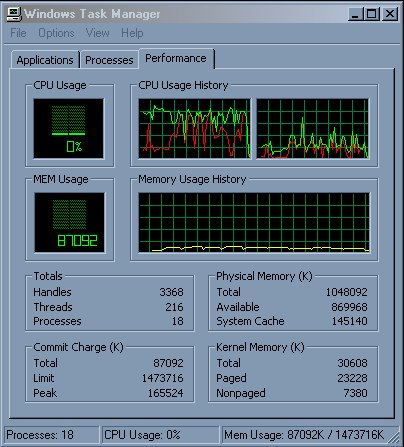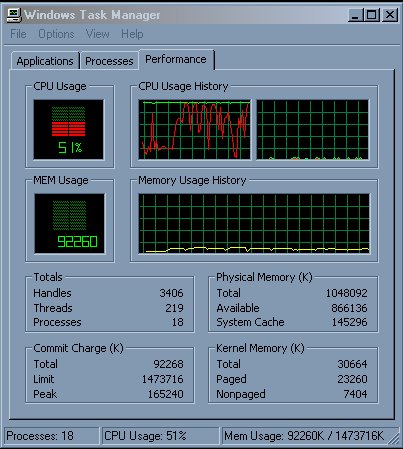Introduction
As I was wandering around the BIOS settings, I thought that I would see what the difference to different memory settings would make. I already knew that “less is better” when it comes to the CAS settings and most memory timings… but how about “DRAM Prefetch?”
I ran the 3DMark2001 on the following configuration multiple times while rebooting in between each one. The table on the next page gives a summary of my findings and the following few pages gives a brief explanation of each run. Want to know the differences between running “Single” and “Dual” CPU with this Benchmark? Read on and you will find out soon enough…
System Configuration
- Dual Pentium III 1 GHz
- Asus CUV4X-D
- v1010 BIOS
- v4.32 4in1 driver
- 1 GB PC-133 Memory
- Elsa GeForce 2 Ultra 64 MB
- nVidia v12.41 drivers
- 3com 905C-TX-M 10/100 NIC
- Sound Blaster Live 5.1
- Win2k WDM default driver
- Windows 2000 SP2
Testing Breakdown
Test numbers 1 and 2:
Test 1 started out as a “default” baseline measurement. I have not changed anything from default. 3012, although not to shabby, needed to be raised a bit for giggles…
Test 2 is JUST changing the SDRAM timings to the fastest settings. This tweak alone was THE single most effective thing anyone could do. Take note: Fast Memory = Fast computer! 🙂
Test number 3:
This ended up being the WORST setting… by going from “default” to “0.0” DRAM read Latch Delay, this configuration beat out all the others for being the slowest…
Test numbers 4 through 7:
These are the slower SDRAM timings to see just what the other settings actually would effect in the results. All settings changed VERY minimally… not even really worth the bother… but one point is one point! Just goes to show that going from “64 MB” to “256 MB” Graphics Aperture Size did not do all that much. An interesting thing happened, though, with test 6, (Byte Merge) After applying this setting and rebooting, my network drives would not connect upon boot. They were still there, but not upon logging in… very strange.
Test number 8 and 9:
In the background, I ran “Task Manager” during test 8 to get a screen shot (Figure 1) of the CPU utilization after the test was complete. In this shot, it looks as though both CPU’s are used during the benchmark testing…but as you soon will see, that is not actually true. Hard to believe? Read on…Test number 9 was just to compile all the previous settings that made a POSITIVE difference in the results, and put them into one. This made the FASTEST settings during test 9.

Test numbers 10 and 11:
These tests gave me the knowledge that either 1) nVidia cards “work” with the “USWC” setting, or 2) that it makes no difference whether it is enabled or not. I really cannot find any information on it… so I guess that STILL will remain a mystery.
Test 11 was the result of increasing the DRAM Read Latch Delay to “1.5.” Funny, the ASUS default settings really WERE the “optimal” ones on this account… 🙂
Test number 12 and 13:
I then, before moving along with test 12, installed the latest (as of now) Direct x 8.0a. I was not really surprised to see that it did not gain any performance with this, but actually, decreased just slightly. Go figure.In the background, I ran “Task Manager” during test 13 to get a screen shot (Figure 2) of the CPU utilization after the test was complete. Remember when I asked if it was using both CPU’s for the test? The results are practically identical to test 8 (taking into account the installation of DirectX 8.0a). This just goes to show that the 3dMark2001 does NOT use dual CPU’s in the benchmark. This is kind of a shame when you think about it. I think that ALL programs should be multi-threaded to some degree.

Summary
| Testing Number | |||||||||||||
|---|---|---|---|---|---|---|---|---|---|---|---|---|---|
| SETTING NAME | 1 | 2 | 3 | 4 | 5 | 6 | 7 | 8 | 9 | 10 | 11 | 12 | 13 |
| CAS Latency | 3 | 2 | 3 | 3 | 3 | 3 | 3 | 2 | 2 | 2 | 2 | 2 | 2 |
| RAS Precharge Time | 3 | 2 | 3 | 3 | 3 | 3 | 3 | 2 | 2 | 2 | 2 | 2 | 2 |
| RAS to CAS Delay | 3 | 2 | 3 | 3 | 3 | 3 | 3 | 2 | 2 | 2 | 2 | 2 | 2 |
| Active to Precharge Time | 6 | 5 | 6 | 6 | 6 | 6 | 6 | 5 | 5 | 5 | 5 | 5 | 5 |
| Read around Write | E | E | E | E | E | E | E | E | E | E | E | E | E |
| CPU-DRAM Back-Back Transaction | E | E | E | E | E | E | E | E | E | E | E | E | E |
| Delayed Transaction | D | D | D | E | D | D | D | E | E | E | E | E | E |
| PCI to DRAM Prefetch | D | D | D | D | E | D | D | D | D | D | D | D | D |
| Byte Merge | D | D | D | D | D | E | D | D | D | D | D | D | D |
| DRAM Read Latch Delay | 1.0 | 1.0 | 0.0 | 1.0 | 1.0 | 1.0 | 1.0 | 1.0 | 1.0 | 1.0 | 1.5 | 1.0 | 1.0 |
| AGP Settings | 4X | 4X | 4X | 4X | 4X | 4X | 4X | 4X | 4X | 4X | 4X | 4X | 4X |
| AGP Drive Strength | Auto | Auto | Auto | Auto | Auto | Auto | Auto | Auto | Auto | Auto | Auto | Auto | Auto |
| Graphics Aperture Size | 64 | 64 | 64 | 64 | 64 | 64 | 256 | 256 | 256 | 256 | 256 | 256 | 256 |
| Video Cache Mode | UC | UC | UC | UC | UC | UC | UC | UC | UC | USWC | UC | UC | UC |
| SCORE | 3012 | 3107 | 2972 | 3013 | 2995 | 3000 | 3013 | 3118 | 3126 | 3123 | 3117 | 3111 | 3113 |
Legend:
Setting #3 = Slowest |
|
||||||||||||
Conclusion
As I was finishing up, I knew that plenty of questions were answered during this session. But, even more scary, it brought
up some new ones…
I wonder how WinXP is going to do?
If you are looking for the best quick tweak, raise up that memory timing, but be warned…it may make your system unstable.
Take care and until next time…
